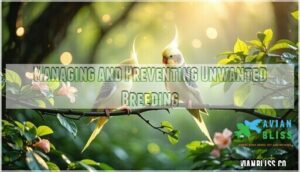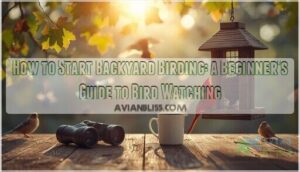This site is supported by our readers. We may earn a commission, at no cost to you, if you purchase through links.

Cockatiels display fascinating mating rituals influenced by age, environment, and seasonal cues. Recognizing the difference between healthy bonding and problematic breeding behavior keeps both you and your feathered companion happier. What looks like quirky personality shifts often reflects deep biological drives that you can either encourage or gently redirect with the right knowledge.
Table Of Contents
- Key Takeaways
- Cockatiel Mating Behavior and Signs
- Bonding and Pair Formation in Cockatiels
- Environmental Triggers Affecting Mating
- Managing and Preventing Unwanted Breeding
- Supporting Healthy Breeding and Chick Development
- Frequently Asked Questions (FAQs)
- Why do cockatiels mate?
- What is cockatiel breeding & mating?
- How do cockatiels behave?
- Do cockatiels mate in winter?
- How do I know if my cockatiels are mating?
- How do I know if my bird is trying to mate with me?
- How to stop cockatiel mating behavior?
- Which month do cockatiels breed?
- How long does mating last?
- What does a female cockatiel look like?
- Conclusion
Key Takeaways
- Cockatiels reach sexual maturity between 8–12 months but shouldn’t breed until at least 18 months old, with males showing courtship behaviors like wing quivering, head bobbing, and elaborate whistling while females display subtler physical changes and receptive postures.
- Environmental factors like extended daylight (over 10 hours), warm temperatures (68–77°F), access to nesting materials, and protein-rich diets directly trigger breeding hormones and mating behavior in captive cockatiels.
- You can prevent unwanted breeding by limiting light exposure to 10–12 hours daily, removing dark enclosed spaces, avoiding petting your bird’s back or wings (which mimics courtship), and restricting warm soft foods that signal breeding season.
- Bonded cockatiel pairs form monogamous relationships that can last years, selecting mates based on behavioral compatibility and engaging in mutual preening, synchronized routines, and coordinated nesting activities that strengthen their lifelong bond.
Cockatiel Mating Behavior and Signs
Understanding your cockatiel’s mating behavior helps you recognize when hormones are at play and how to respond appropriately.
You’ll notice distinct physical changes, vocal patterns, and courtship displays that signal breeding readiness.
Here’s what to watch for in both male and female cockatiels as they reach sexual maturity.
Sexual Maturity and Mating Age
Most cockatiels reach sexual maturity somewhere between eight and twelve months old, though you might notice subtle hormonal shifts appearing as early as six months in some birds. Males generally show readiness for mating behavior slightly earlier than females, and you’ll see this reflected in their developing courtship behaviors and increased vocalizations.
Keep in mind that sexual maturity doesn’t always align with ideal breeding age—most experts recommend waiting until your cockatiel is at least eighteen months old to guarantee full physical development and reproductive health.
Physical Signs in Males and Females
Once your cockatiel hits that maturity window, you’ll start noticing some pretty clear physical cues that signal breeding readiness—and these signs look different depending on whether you’re watching a male or female.
Male cockatiels often display brighter beak color changes and more dramatic crest feather signs during courtship displays, while females usually show increased feather preening and subtle behavioral shifts that hint at their readiness to bond and nest.
Typical Mating Vocalizations
When those physical signs start showing up, you’ll probably notice the soundtrack changes too—males especially become much more vocal, using specific whistles, chirps, and soft calls that basically announce "I’m ready to pair up."
These courtship songs aren’t random—vocalization patterns follow predictable rhythms, often peaking at sunrise and sunset. Mating calls can range from persistent whistling behaviors to softer breeding chirps, forming a rich avian communication system that helps cockatiels signal readiness and attract compatible partners.
Quivering, Courtship, and Grooming
Beyond the whistles and calls, you’ll start seeing actual physical behaviors—quivering wings, head-bobbing displays, and mutual preening sessions that look surprisingly tender for birds who spent their whole lives solo.
Cockatiel quivering is a classic courtship display, where males fan their wings slightly and shake them while vocalizing. Feather grooming and beak rubbing strengthen social bonding—these cockatiel courtship rituals signal trust and compatibility, laying the groundwork for pair formation and cockatiel mating behavior that follows naturally from this cockatiel bonding behavior.
Bonding and Pair Formation in Cockatiels
When cockatiels choose a mate, it’s not just about proximity—it’s about chemistry. These social birds follow distinct courtship patterns and form bonds that can last years.
Let’s look at how they pick partners, what their courtship looks like, and why some pairs click while others don’t.
Courtship Rituals and Displays
If you’ve ever watched a male cockatiel show off for a potential mate, you know it’s part theater, part instinct, and entirely mesmerizing. He’ll strut with his crest raised high, wings slightly spread, while producing rhythmic mating calls that signal his intentions.
These courtship displays include head bobbing, hopping, and mirror-seeking behavior—visual cues designed for mate attraction. The female observes these ritualistic behaviors carefully, deciding whether this suitor is worthy of forming a pair bond.
Pair Bonding and Monogamy
Once the courtship dance concludes and a female accepts her mate, something extraordinary unfolds—a partnership rooted in loyalty that can span years, not just seasons. Cockatiels usually form monogamous pair bonds, showing strong mate preference even within larger flocks. While “divorce rates” exist in captivity, bond strength usually remains solid once established—your cockatiel’s companion choice reflects deep emotional connection, not convenience.
When cockatiels pair, they form monogamous bonds rooted in loyalty that often last years, not seasons
Key aspects of cockatiel pair bonding:
- Mutual preening strengthens bonds – Paired birds groom each other daily, reinforcing their connection through physical affection.
- Synchronized routines emerge naturally – Bonded pairs eat, sleep, and vocalize together, creating predictable patterns you’ll notice.
- Lifelong bonds are common – Many cockatiel pairs remain together for their entire lives, demonstrating true monogamy.
Compatibility and Mate Selection
Not all cockatiels click instantly—mate choice hinges on behavioral compatibility, social hierarchy, and visual cues like plumage brightness. Larger females with fewer parasites tend to be pickier, while males compete through displays and nest preparation.
Environmental readiness matters too: the right nesting space can trigger courtship. Notably, younger birds often reject partners until they’re mature enough to form lasting pair bonds.
The breeding process involves complex behaviors, including those related to cockatiel mating, which are vital for successful pairing.
Environmental Triggers Affecting Mating
Your cockatiel’s body doesn’t operate on a calendar—it reacts to the world around it. Light, warmth, accessible hiding spots, and even what’s in the food bowl can flip the switch on breeding behavior faster than you might expect.
Let’s look at the specific environmental factors that tell your bird it’s time to nest.
Impact of Daylight and Temperature
Your cockatiel’s breeding instincts don’t just come alive randomly—they respond directly to daylight and warmth. When daily light exposure stretches beyond 10 hours, their circadian systems flip the hormonal switch, triggering gonadal development and courtship rituals.
Temperature control matters too. Warmer environments between 68–77°F support successful egg viability and chick development, while cooler conditions can halt breeding cycles altogether.
Managing photoperiod effects and environmental stimulation in your home gives you real control over unwanted cockatiel mating signs and breeding habits. Understanding the bird social structure is vital for creating an ideal breeding environment.
Availability of Nesting Materials and Spaces
When shredded paper piles up in a corner or your bird starts eyeing that cozy cardboard box, you’re watching nesting instincts kick into high gear. Providing—or removing—certain materials directly influences courtship and pair bond formation.
Controlling nesting material availability and nesting box placement gives you practical leverage over breeding cycles.
Nesting triggers to manage:
- Dark, enclosed spaces like boxes or fabric tents signal ideal nesting area conditions
- Shredded paper, leaves, or soft materials encourage weaving and nest-building behaviors
- Strategic perch arrangement and cage design modifications can reduce access to potential nest sites
Dietary Changes That Stimulate Breeding
A protein-rich diet doesn’t just fuel your cockatiel’s body—it flips a biological switch that says, "Time to raise a family." Managing protein levels and nutrient balance helps control hormonal behavior and unwanted breeding triggers.
Adjusting these elements gives you practical control over avian behavior and breeding triggers in your cockatiel care routine.
| Dietary Factor | Impact on Breeding Behavior |
|---|---|
| High protein foods (eggs, legumes) | Signals favorable conditions for reproductive behavior |
| Warm, soft foods fed by hand | Mimics regurgitation during courtship rituals |
| Excessive calcium supplements | Readies hens physiologically for egg production |
| Seed restrictions with fresh food introduction | Reduces caloric density that stimulates mating cycles |
Managing and Preventing Unwanted Breeding
If you’re not planning to breed your cockatiels, you’ll need to understand what triggers their reproductive drive so you can redirect it.
The right adjustments to their environment and your daily routine can keep hormones in check without stress.
Here’s what actually works to discourage nesting and mating behavior.
Limiting Access to Nesting Sites
If your cockatiel suddenly starts gravitating toward dark corners, boxes, or even the space behind your couch, you’re witnessing the pull of instinct—one that’s surprisingly easy to redirect once you understand what’s driving it.
Nest site blocking means removing cozy hiding spots that trigger breeding behavior. Rearrange your cage design to eliminate enclosed areas, and swap out nesting material like shredded paper for foraging alternatives. Rotate toys regularly to keep your bird mentally engaged rather than focused on nest building.
Adjusting Light Exposure and Daily Routine
Your bird’s internal calendar doesn’t run on seasons—it runs on light, and that’s exactly why manipulating day length is one of your most powerful tools for cooling down hormonal surges.
Light Cycle Management is fundamental to Photoperiod Control and regulating your cockatiel’s Circadian Rhythm. Here’s how Daily Routine Adjustments discourage breeding conditions:
- Limit daylight to 10-12 hours maximum—extended light mimics spring, triggering avian reproduction instincts
- Cover the cage consistently each evening to enforce darkness and proper sleep cycles
- Avoid artificial lighting after sunset that disrupts natural avian behavior patterns
- Maintain predictable wake-sleep schedules to stabilize hormones linked to cockatiel breeding habits
- Combine reduced photoperiods with Environmental Enrichment like foraging toys to redirect focus away from cockatiel courtship rituals
Modifying Social and Handling Practices
Light isn’t the only switch you need to flip—how you touch, manage, and interact with your bird can either fuel the fire or help extinguish it.
Social Interaction and Management Techniques directly influence Pet Bird Behavior. Stroking your cockatiel’s back, wings, or vent mimics courtship rituals and triggers hormonal responses. Understanding Bird Psychology through Owner Education helps you apply effective Behavioral Modification.
| Avoid | Instead |
|---|---|
| Petting back, wings, tail area | Limit touch to head and feet only |
| Cuddling inside clothing or blankets | Keep bird on perch or shoulder |
| Hand-feeding warm, soft foods | Offer food in dish at room temperature |
| Allowing nesting in hair or pockets | Redirect to Environmental Enrichment toys |
| Extended one-on-one bonding sessions | Incorporate varied Animal Socialization with multiple people |
Redirecting affection through Pet Owner Education prevents unwanted breeding behaviors while maintaining a healthy bond.
Supporting Healthy Breeding and Chick Development
If you’re planning to breed your cockatiels, you’ll want to support them properly through the entire process. This means adjusting their diet, caring for eggs during incubation, and monitoring chicks as they grow.
Here’s what you need to know to help your birds through a healthy breeding cycle.
Nutritional Needs for Breeding Birds
Breeding season demands precision in avian care and management—think of proper nutrition as the foundation supporting reproductive health in birds. Protein requirements need to be boosted to 12-20% of the diet, ensuring adequate amino acids like lysine and methionine for healthy chick development.
Calcium balance is critical: aim for 0.6-1% calcium with a 1.4:1 to 2:1 calcium-to-phosphorus ratio to prevent egg binding and skeletal issues. Vitamin supplements, particularly 4,000 IU/kg of vitamin A, support feather growth and immune function.
Energy intake naturally increases during breeding, so quality pellets designed for reproduction help meet these heightened nutritional demands while providing proper care and nutrition for pet birds throughout this delicate phase.
Egg Care, Incubation, and Brooding
Once your hen lays that first egg, the real work begins—temperature, humidity, and vigilance become your daily rhythm for the next 18 to 21 days.
Egg turning happens naturally as parents shift locations in the nesting boxes, preventing embryo adhesion. Most pairs share incubation duties, though hens usually brood overnight.
Monitor parental care closely—some first-time breeders need gentle encouragement during this vital breeding season phase.
Chick Feeding, Weaning, and Growth Monitoring
Watching those tiny beaks break through the shell is just the beginning—from that first hungry peep to their maiden flight, chick development demands constant observation, adjustment, and trust in the parents’ instincts. Most pairs manage parental care beautifully, but you’ll want to track these development stages:
- Days 1-7: Chicks rely entirely on crop milk; monitor feeding schedules and weight gain daily
- Weeks 2-4: Pin feathers emerge; parents increase chick nutrition through regurgitated seed
- Weeks 5-8: Weaning techniques begin as fledglings test independence while parents gradually reduce feeds
Keep basic growth charts handy—sudden weight drops signal problems requiring immediate intervention.
Frequently Asked Questions (FAQs)
Why do cockatiels mate?
Birds of a feather flock together—and cockatiels are no exception.
Mating behaviors stem from deep instincts tied to survival and species continuation, driven by hormonal changes and genetic predisposition that activate during breeding cycles.
What is cockatiel breeding & mating?
Cockatiel breeding involves pair bonding, courtship rituals, and mate selection within flock dynamics. Mating rituals include vocalizations, quivering, and mutual grooming.
Breeding cycles follow environmental triggers, with genetics influencing offspring characteristics through avian courtship rituals.
How do cockatiels behave?
Feathered friends aren’t just wing-and-a-prayer companions—they’re deeply social creatures. Your cockatiel thrives on flock dynamics and cockatiel bonding behavior, using bird body language like crest position to signal mood.
They’re natural communicators, whistling, chirping, and grooming.
Do cockatiels mate in winter?
In captivity, seasonal mating patterns fade. Temperature effects and breeding cycles become less pronounced than in the wild, where cold weather naturally suppresses breeding habits.
Most pet cockatiels can exhibit mating behavior year-round if environmental triggers are present.
How do I know if my cockatiels are mating?
Look for increased vocalizations—soft chirps, warbles, or whistles—paired with quivering wings and tail feathers. Males often display courtship displays while females adopt receptive postures.
Watch for mutual preening, regurgitation attempts, and nesting behavior like shredding paper or exploring dark spaces, all classic mating signs and breeding cues in pair bonding cockatiels.
How do I know if my bird is trying to mate with me?
If your cockatiel backs up against your hand, raises its tail, and starts making soft chirps or cooing sounds while quivering slightly, these are classic mating behaviors directed at you as a bonded companion.
How to stop cockatiel mating behavior?
Think of hormones like a light switch you can dim. You’ll need to reduce mating behavior through environmental control—shortening daylight exposure to 10-12 hours, removing nesting materials, and limiting physical contact that mimics courtship rituals.
Which month do cockatiels breed?
In the wild, Australian cockatiels don’t follow strict Breeding Seasons—they respond to rainfall and food abundance.
Captive birds, however, can breed year-round when conditions trigger hormonal changes. Spring and summer naturally stimulate Mating Cycles through longer daylight hours.
How long does mating last?
The actual physical act takes only seconds—usually five to fifteen. But don’t let that brief moment fool you.
Your pair spends days or even weeks in courtship rituals first, and mating call exchanges can stretch across hours.
After successful pairing, they’ll breed repeatedly throughout their fertility window.
What does a female cockatiel look like?
Females generally show subtler coloring than males—duller cheek patches, barred tail feathers, and spotted yellow markings beneath their wings.
Their beaks and body size match males closely, though their head shape appears slightly rounder overall.
Conclusion
Reading your cockatiel’s body language is like learning a second language—one that speaks through wing flutters, bobbing heads, and persistent serenades.
Whether you’re nurturing a breeding pair or helping a hormonal single bird find balance, understanding cockatiel mating behavior transforms confusing episodes into manageable moments. Your bird isn’t being difficult; they’re simply following instincts that have guided their species for millennia.
With the right environmental adjustments and attentive care, you’ll create a space where your feathered companion thrives emotionally, regardless of whether eggs ever enter the picture.











